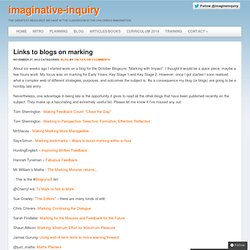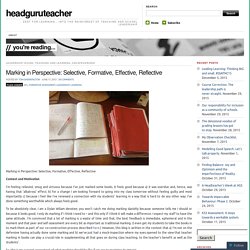

Links to blogs on marking. About six weeks ago I started work on a blog for the October Blogsync “Marking with Impact”, I thought it would be a quick piece, maybe a few hours work.

My focus was on marking for Early Years, Key Stage 1 and Key Stage 2. However, once I got started I soon realised what a complex web of different strategies, purposes, and outcomes the subject is. As a consequence my blog (or blogs) are going to be a horribly late entry. Nevertheless, one advantage in being late is the opportunity it gives to read all the other blogs that have been published recently on the subject. They make up a fascinating and extremely useful list. Tom Sherrington - Making Feedback Count: “Close the Gap” Tom Sherrington - Marking in Perspective: Selective, Formative, Effective, Reflective MrStacey - Making Marking More Manageable SaysSimon - Marking bookmarks – Ways to boost marking within school HuntingEnglish – Improving Written Feedback Hannah Tyreman – Fabulous Feedback - This is the #Blogsync8 list: The Joy of Public.
Marking in Perspective: Selective, Formative, Effective, Reflective ? headguruteacher. Marking in Perspective: Selective, Formative, Effective, Reflective Context and Motivation I’m feeling relieved, smug and virtuous because I’ve just marked some books.

It feels good because a) it was overdue and, hence, was having that ‘albatross’ effect; b) for a change I am looking forward to going into my class tomorrow without feeling guilty and most importantly c) because I feel like I’ve renewed a connection with my students’ learning in a way that is hard to do any other way; I’ve done something worthwhile which always feels good. To be absolutely clear, I am a Dylan Wiliam devotee; you won’t catch me doing marking slavishly because someone tells me I should or because it looks good; I only do marking if I think I need to – and this only if I think it will make a difference.
I expect my staff to have the same attitude. So, this is my current assessment of what marking should be like if we are to maximise its impact: Marking should be selective: Marking should be formative: Like this: Marking is an act of love. Have you ever flicked back through an exercise book and seen the same repeated comments followed with soul numbing certainty by the same repeated mistakes?

There are few things more crushing to the spirit of hardworking teachers than this dramatically enacted evidence of the fact that, apparently, 70% of all feedback given by teachers to pupils falls on stony soil. I’ve seen my fair share of books like these. Heck! I’ve been responsible for more than my fair share of ‘em! I’ve always felt guilty about marking. I guess if you’re marking like I used to, then it’s easy to feel like this. The big difference is DIRT. At Clevedon School, this has been formalised into Triple Impact Marking: Here are a few of my thoughts on how to change the way you think about marking and, maybe more importantly, how you go about it. and Joe Kirby has also written about how using symbols can save precious time. Don’t write out comments. And what about this absurdly simple strategy taken from Doug Lemov’s blog?